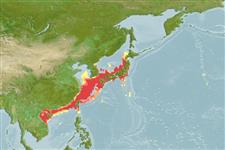Mixini (Missine) (hagfishes) >
Myxiniformes (Hagfishes) >
Myxinidae (Hagfishes) > Eptatretinae
Etymology: Eptatretus: hepta (Gr.), seven; tretos (Gr.), perforated (i.e., with holes), referring to seven gill apertures on what would later be described as Homea banksii (=E. cirrhatus) [range within genus is 6-14 pairs of gill apertures]. (See ETYFish); burgeri: In honor of German physicist and biologist Heinrich Bürger (ca. 1804-1858), who collected type. (See ETYFish).
More on author: Girard.
Environment: milieu / climate zone / depth range / distribution range
Ecologia
marino demersale; non migratori; distribuzione batimetrica 10 - 270 m (Ref. 31276). Temperate
Northwest Pacific: Sea of Japan and eastern Japan to Taiwan.
Size / Peso / Age
Maturity: Lm ? range ? - ? cm
Max length : 60.0 cm TL maschio/sesso non determinato; (Ref. 559)
Short description
Morfologia | Morfometria
Six pairs of gill pouches and gill apertures in a rarely variable linear arrangement. Branchial slime pores, 4-6. The last left gill aperture (GA) is closely adjacent to but separate from the pharyngocutaneous duct (PCD). Eyes spots are prominent (Ref. 31545). White mid-dorsal line prominent; fused cusps 3/2, total cusps 40-42; total slime pores 81-92 (Ref. 51420).
Found in the sublittoral zone (Ref. 11230). Usually buries itself in bottom mud (Ref. 26686). Migrates into deeper water to spawn (Ref. 51361, 51374). This is the only member of the family having a seasonal reproductive cycle (Ref. 51361). Food fish in Japan. Hide is processed into leather and exported worldwide, usually as 'eel' leather.
Copulatory organ absent. The gonads of hagfishes are situated in the peritoneal cavity. The ovary is found in the anterior portion of the gonad, and the testis is found in the posterior part. The animal becomes female if the cranial part of the gonad develops or male if the caudal part undergoes differentiation. If none develops, then the animal becomes sterile. If both anterior and posterior parts develop, then the animal becomes a functional hermaphrodite. However, hermaphroditism being characterised as functional needs to be validated by more reproduction studies (Ref. 51361 ). However, there was a presumption of 0.1% or even less that this species manifests functional hermaphroditism (Ref. 51416).
This is the only member of the family having a seasonal reproductive cycle (Ref. 51361).
Fernholm, B., 1998. Hagfish systematics. p. 33-44. In J.M. Jørgensen, J.P. Lomholt, R.E. Weber and H. Malte (eds.) The biology of hagfishes. Chapman & Hall, London. 578 p. (Ref. 31276)
IUCN Red List Status (Ref. 130435)
Threat to humans
Harmless
Human uses
Pesca: commerciale; esca: usually
Informazioni ulteriori
Age/SizeAccrescimentoLength-weightLength-lengthLength-frequenciesMorfometriaMorfologiaLarveDinamica popolazioni larvaliReclutamentoAbbondanzaBRUVS
BibliografiaAcquacolturaProfilo di acquacolturaVarietàGeneticaElectrophoresesEreditarietàMalattieElaborazioneNutrientsMass conversion
Strumenti
Special reports
Download XML
Fonti Internet
Estimates based on models
Preferred temperature (Ref.
123201): 11.1 - 23.4, mean 18.8 °C (based on 182 cells).
Phylogenetic diversity index (Ref.
82804): PD
50 = 0.5000 [Uniqueness, from 0.5 = low to 2.0 = high].
Bayesian length-weight: a=0.00204 (0.00092 - 0.00452), b=2.93 (2.73 - 3.13), in cm total length, based on LWR estimates for this (Sub)family-body shape (Ref.
93245).
Trophic level (Ref.
69278): 4.5 ±0.80 se; based on food items.
Resilienza (Ref.
120179): Basso, tempo minimo di raddoppiamento della popolazione 4.5 - 14 anni (Fec assumed to be <100).
Fishing Vulnerability (Ref.
59153): Moderate vulnerability (44 of 100).
